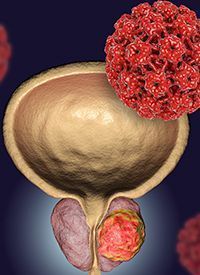Article
Positive Harm-Benefit Data Found in PSA Screening for Black Patients With Prostate Cancer
Author(s):
Complementary approaches to quantifying overdiagnosis generated a more beneficial harm-benefit tradeoff of prostate-specific antigen screening, compared with previous estimates that used shorter follow-up from the introduction of screening.
Prostate Cancer

Complementary approaches to quantifying overdiagnosis generated a more beneficial harm-benefit tradeoff of prostate-specific antigen (PSA) screening, compared with previous estimates that used shorter follow-up from the introduction of screening in Black patients with prostate cancer, according to findings presented during the 2022 American Urological Association Annual Meeting.1
These data strongly support prostate-specific antigen (PSA) screening, particularly in Black men, for whom there is a paucity of clinical trial evidence, according to Spyridon Basourakos, MD, urology resident at New York Presbyterian Weill Cornell Medical Center, who presented the data.
The epidemiology of prostate cancer within the United States has been impacted by prostate-specific antigen screening. Because of persistent racial disparities in outcomes for Black men, re-examination within this patient population is needed to provide understanding of the harms and benefits of screening relative to cancer-specific mortality.
During the study, experts estimated both overdiagnosis and overtreatment for all races, including Black men ranging between 50-84 years of age until 2016, which was the most recent year with treatment data available. Investigators looked at the potential harms and benefits of this population based on screening for prostate cancer in the United States based on the Surveillance, Epidemiology, and End Results (SEER) registry and United States census data between 1986-2016. Further, an established microsimulation model of prostate cancer natural history was used.
By combining estimates with plausible mortality benefits, the numbers needed to diagnose (NND) and numbers needed to treat (NNT) were calculated in order to prevent prostate cancer deaths. Researchers looked at the ways in which all races, and specifically Black men, differ with prostate-specific mortality.
Patients of all races were evaluated, and findings estimated there to be 1.5-1.9 million (range between estimation approaches) overdiagnosed and 0.9-1.5 million overtreated prostate cancers in the United States by 2016. Over the period of 1986-2016, researchers looked at where PSA screening started, and the 2 estimation approaches produced similar age-standardized burdens of overdiagnosis.
Prostate cancer mortality showed an initial rise in and then declined relative to 1986, with 270,000 fewer deaths among men of all races and 55,000 fewer deaths among Black men. By assuming that half of the 270,000 total prostate cancer deaths that were avoided until 2016 were due to screening, the NND and NNT would be 11-14 and 7-11 for all races and 8-12 and 5-9 for Black men.
Further, the estimated NND and NNT for Black men reaches well into the low single digits when researchers account for the lag between incidence and mortality.
Overall, there was a greater benefit in NND and NNT was shown within Black men compared to all races. While a dramatic improvement was seen in prostate cancer mortality in Black men, comparing this rate of death to individuals of all races showed that there was a still higher than double mortality rate seen in Black men with prostate cancer.
Still, the need to quantify overdiagnosis, overtreatment, and the harm-benefit trade off in PSA treatment in Black men exists. More work is needed to be done to understand why Black men are having a significantly higher and dramatic mortality rate, according to Basourakos et al.
Reference
- S Basourakos, R Gulati, R Vince, et al. Harm-to-Benefit of Three Decades of Prostate Cancer Screening in Black Men. Presented at: 2022 American Urology Association Annual Meeting; May 13-16, 2022; New Orleans, LA. Abstract LBA01-01









